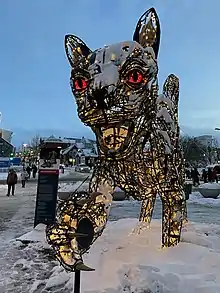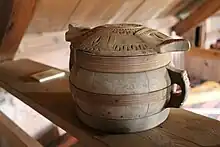Icelandic Christmas folklore
Icelandic Christmas folklore depicts mountain-dwelling characters and monsters who come to town during Christmas. The stories are directed at children and are used to scare them into good behavior. The folklore includes both mischievous pranksters who leave gifts during the night and monsters who eat disobedient children.
_%D0%BD%D0%B0_%D0%BB%D0%B5%D1%82%D0%BE%D0%B2%D0%B8%D1%89%D1%96_%D0%9A%D0%B5%D0%BF%D0%BB%D0%B0%D0%B2%D1%96%D0%BA.jpg.webp)
The figures are depicted as living together as a family in a cave and include:
- Grýla, a giantess with an appetite for the flesh of mischievous children, whom she cooks in a large pot. Her husband Leppalúði is lazy and mostly stays at home in their cave.
- The Yule Cat is a huge and vicious cat who lurks about the snowy countryside during Christmas time (Yule) and eats people who have not received any new clothes to wear before Christmas Eve.
- The Yule Lads are the sons of Grýla and Leppalúði. They are a group of 13 mischievous pranksters who steal from or harass the population and all have descriptive names that convey their favorite way of harassing.[1] They come to town one by one during the last 13 nights before Yule. They leave small gifts in shoes that children have placed on window sills, but if the child has been disobedient they instead leave a rotten potato in the shoe.
These Christmas-related folktales first appeared around the 17th century and displayed some variation based on region and age. In modern times these characters have taken on slightly more benevolent roles.[2]
History
Origins
The first mention of the Yule Lads can be found in the 17th-century Poem of Grýla. Grýla had appeared in older tales as a troll but had not been linked to Christmas before. She is described as a hideous being who is the mother of the gigantic Yule Lads, a menace to children.
Early on, the number and depiction of the Yule Lads varied greatly depending on location. They were used to frighten children into good behaviour, similar to the bogeyman. The King of Denmark objected to their use as a disciplinary tool.[3]
In the late 18th century, a poem mentions 13 of them. In the mid-19th century, author Jón Árnason drew inspiration from the Brothers Grimm and began collecting folktales. His 1862 collection is the first mention of the names of the Yule Lads.[3]
In 1932, the poem "Yule Lads" was published as a part of the popular poetry book Christmas is Coming (Jólin koma) by Icelandic poet Jóhannes úr Kötlum. The poem was popular and established what is now considered the canonical 13 Yule Lads, their names, and their personalities.
Grýla & Leppalúði
Grýla[lower-alpha 1] is a giantess, first mentioned in 13th-century texts such as Íslendinga saga and Sverris saga,[4] but not explicitly connected with Christmas until the 17th century. She is enormous and her appearance is repulsive.
The oldest poems about Grýla describe her as a parasitic beggar. She walks around asking parents to give her their disobedient children. Her plans can be thwarted by giving her food or chasing her away. Originally, she lived in a small cottage, but in later poems, she appears to have been forced out of town and into a remote cave.
Current-day Grýla can detect children who are misbehaving year-round. She comes from the mountains during Christmas time to search nearby towns for her meal. She leaves her cave, hunts children, and carries them home in her giant sack. She devours children as her favourite snack. Her favorite dish is a stew of naughty kids, for which she has an insatiable appetite. According to legend, there is never a shortage of food for Grýla.
According to folklore, Grýla has been married three times. Her third husband Leppalúði[lower-alpha 2] is said to be living with her in their cave in the Dimmuborgir lava fields, with the big black Yule Cat and their sons. Leppalúði is lazy and mostly stays at home in their cave. Grýla supposedly has dozens of children with her previous husbands, but they are rarely mentioned nowadays.
Yule Cat

The Yule Cat, known as Jólakötturinn,[lower-alpha 3] a huge and vicious cat who is described as lurking about the snowy countryside during Christmas time and eating people who have not received any new clothes to wear before Christmas Eve.[5] He is the house pet of Grýla and her sons.[6]
Though referred to as an ancient tradition, written accounts of the Yule Cat have only been located as recently as the 19th century.[7] The threat of being eaten by the Yule Cat was used by farmers as an incentive for their workers to finish processing the autumn wool before Christmas. The ones who took part in the work would be rewarded with new clothes, but those who did not would get nothing and thus be preyed upon by the monstrous cat.[5] The cat has alternatively been described as merely eating away the food of ones without new clothes during Christmas feasts. The perception of the Yule Cat as a man-eating beast was partly popularized by poems of Jóhannes úr Kötlum as with the rest of the folklore.
Yule Lads

The Yule Lads[lower-alpha 4] (sometimes named Yuletide-lads or Yulemen) are the sons of Grýla and Leppalúði. They are a group of 13 mischievous pranksters who steal from or otherwise harass the population. All have descriptive names that generally convey their favourite way of causing mischief.[1] They arrive one by one over the final 13 nights leading up to Christmas (Yule). They leave small gifts in shoes that children place on window sills, but if the child has been disobedient, they leave a rotten potato in the shoe instead.
In modern times the Yule Lads have also been depicted in a more benevolent role[2] comparable to Santa Claus and other related figures. They are generally portrayed wearing late-medieval Icelandic clothing, but are sometimes shown in the costume traditionally worn by Santa Claus, especially at children's events.
List of Yule Lads
The Yule Lads arrive over the course of the last 13 nights before Christmas, beginning on 12 December.[8] One then departs each day, beginning on Christmas Day, in the order that they arrived; thus each of them stays for 13 days.[9] Below are the canonical 13 Yule Lads in the order they arrive (and depart):
| Icelandic name | English translation | Description[10] | Arrival[10] | Departure |
|---|---|---|---|---|
| Stekkjarstaur | Sheep-Cote Clod | Harasses sheep, but is impaired by his stiff peg-legs. | 12 December | 25 December |
| Giljagaur | Gully Gawk | Hides in gullies, waiting for an opportunity to sneak into the cowshed and steal milk. | 13 December | 26 December |
| Stúfur | Stubby | Abnormally short. Steals pans to eat the crust left on them. | 14 December | 27 December |
| Þvörusleikir | Spoon-Licker | Steals and licks wooden spoons. Is extremely thin due to malnutrition. | 15 December | 28 December |
| Pottaskefill | Pot-Scraper | Steals leftovers from pots | 16 December | 29 December |
| Askasleikir | Bowl-Licker | Hides under beds, waiting for someone to put down their askur (a type of bowl with a lid used instead of dishes), which he then steals. | 17 December | 30 December |
| Hurðaskellir | Door-Slammer | Likes to slam doors, especially during the night, waking people up | 18 December | 31 December |
| Skyrgámur | Skyr-Gobbler | Has a great affinity for skyr (similar to yogurt) | 19 December | 1 January |
| Bjúgnakrækir | Sausage-Swiper | Hides in the rafters and snatches sausages that are being smoked | 20 December | 2 January |
| Gluggagægir | Window-Peeper | A snoop who looks through windows in search of things to steal | 21 December | 3 January |
| Gáttaþefur | Doorway-Sniffer | Has an abnormally large nose and an acute sense of smell which he uses to locate leaf bread (laufabrauð) | 22 December | 4 January |
| Ketkrókur | Meat-Hook | Uses a hook to steal meat | 23 December | 5 January |
| Kertasníkir | Candle-Stealer | Follows children in order to steal their candles (which were once made of tallow and thus edible) | 24 December | 6 January |
Names in English are based on Hallberg Hallmundsson's translation of the poem.[11]
Obscure Yule Lads
Before these 13 Yule Lads became the most popular, their description varied between locations. Some were said to be sons of Grýla; others were her brothers. Some stories only describe nine Yule Lads, but every one of them had their own characteristic prank.
Most of the different Yule Lads can be classified into groups: those who steal food, those who like to play tricks or harass, and those who seem to be a delusion from nature (for example, Gully Gawk, who just hides in gullies).[3]
In the east of Iceland, there existed a folk tale of a specific group of Yule Lads. They did not come from the mountains but the ocean. One very obscure nursery rhyme mentions two female Yule pranksters who steal melted fat by either stuffing it up their noses or putting it in socks.[3]
Notes
References
- Nannaa (23 December 2008). "The Yule Lads: Friends or Foes?". Iceland Review. Archived from the original on 22 January 2013. Retrieved 1 June 2013.
- Chapman, Richard. "The Icelandic Yule Lads and their evil mother Gryla". Guide to Iceland. Retrieved 12 December 2022.
- Björnsson, Árni (2003). "Árni Björnsson – Nöfn Jólasveina". Stofnun Árna Magnússonar. Archived from the original on 4 May 2018. Retrieved 5 December 2020.
- Gunnell, Terry. "Grýla, Grýlur, Grøleks And Skeklers". Christmas in Iceland 2000. Archived from the original on 13 October 2006.
- The Yule Cat (Christmas in Iceland 2000)
- Jólakötturinn (National Museum of Iceland) Archived 22 December 2015 at the Wayback Machine (in Icelandic)
- Magnússon, Haukur (10 December 2008). "The Christmas Cat". Grapevine. Fröken Ltd. Retrieved 28 November 2015.
- "The Yule Lads". National Museum of Iceland. Archived from the original on 30 October 2016. Retrieved 1 June 2013.
- Crump, William D. (28 August 2013). The Christmas Encyclopedia (3rd ed.). McFarland. p. 238. ISBN 978-1-4766-0573-9.
- "Celebrating Christmas with 13 trolls". Promote Iceland. Retrieved 1 June 2013.
- "Hallberg Hallmundson's translation of 'Jólasveinarnir' by Jóhannes úr Kötlum". Jóhannes úr Kötlum, skáld þjóðarinnar. Archived from the original on 22 December 2007. Retrieved 2 April 2008.
Further reading
- "Christmas in Iceland". Embassy of Iceland, Washington DC. Archived from the original on 2 December 2013.
- "Grýla og jólasveinar". jol.ismennt.is. Archived from the original on 18 November 2005. Pictures by Halldor Petursson ca. 1950.
- "The Yule Lads". Jo's Icelandic Recipes. Archived from the original on 2 April 2015.
- "Jólasveinarnir (Yuletide Lads)". Yule in Iceland. Archived from the original on 24 July 2011.
- Petursson, Olafur. "The Yuletide Lads". Bokband.com. Archived from the original on 22 December 2007. A translation of the poem by Jóhannes úr Kötlum.
- "Christmas in Iceland". jol.ismennt.is. Archived from the original on 11 November 2006. A comprehensive site on Christmas in Iceland with much information about Yule Lads and Grýla.
- Gunnell, Terry. "Grýla, Grýlur, Grøleks and Skeklers: Folk Drama in the North Atlantic in the Early Middle Ages?". jol.ismennt.is. Archived from the original on 13 October 2006.